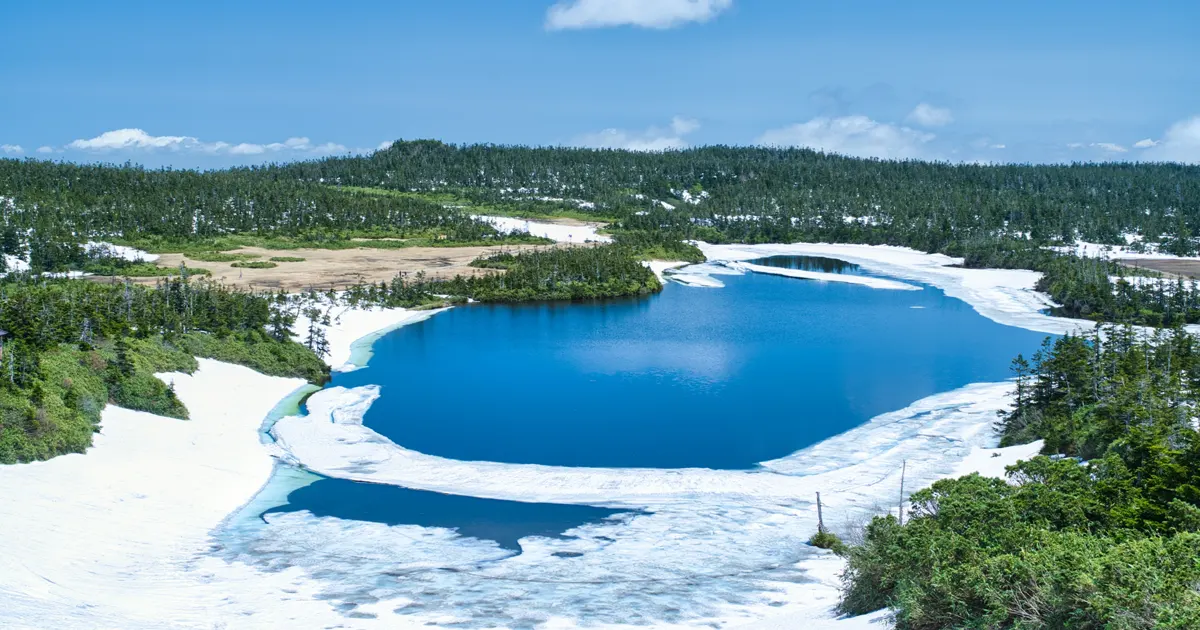Surrounded by quiet mountains and drifting sea clouds, the mysterious “Dragon Eye ” appears as the snow begins to melt—this is Towada-Hachimantai National Park , stretching across Iwate and Akita in the Tohoku region. Volcanic landscapes, hot springs, and the scenic Aspite Line invite visitors into an extraordinary realm.
This article introduces key highlights of the Hachimantai area in a Q&A format, designed for solo travelers and first-time visitors to Japan. It includes helpful travel tips, best visiting seasons, and essential guidance to ease your journey.
If you’re planning your trip and unsure where to begin, let this guide help you discover the natural beauty and hot springs of Tohoku.
Contents
Towada-Hachimantai Access Guide for First-Time Visitors
Check the latest weather forecast before your visit: [weathernews ]
By Train
Tokyo Station
Take the Tohoku Shinkansen “Hayabusa” to Morioka Station (approx. 2 hr 20 min)
From Morioka Station, take the Iwate Kenpoku Bus bound for “Hachimantai Summit” and get off at “Hachimantai Visitor Center” (approx. 1 hr 40 min)
Total travel time: approx. 4 hr
Sendai Station
Take the Tohoku Shinkansen to Morioka Station (approx. 1 hr 10 min)
From Morioka Station, take the Iwate Kenpoku Bus bound for “Hachimantai Summit” and get off at “Hachimantai Visitor Center” (approx. 1 hr 40 min)
Total travel time: approx. 3 hr 10 min
One Point Advice
Visitor Info: Hours, Tickets & Directions
Top Things to Do in Towada-Hachimantai
Hachimantai Dragon Eye|Snow-Crafted Eye of Nature
Visible only from late May to mid-June, the “Dragon Eye ” is a rare natural phenomenon that appears in Kagami-numa Pond near the summit. As the snow melts, water gathers in the center of the white snowfield, resembling a dragon’s eye. The trail is well maintained and accessible for beginners. Since visibility of the Dragon Eye depends on weather, checking official updates before visiting is highly recommended.
Duration: 20–30 min (one-way from parking lot)
Admission: Free
Aspite Line|Scenic Drive Between Volcanoes
This 27-kilometer scenic drive connects Iwate and Akita and offers the ultimate mountain driving experience . You’ll see snow walls, sweeping cloudscapes, and vibrant autumn colors—each season brings different views. There are multiple scenic viewpoints and parking areas along the Aspite Line route. Even bus travelers can enjoy it by getting off near the summit and walking around on foot.
Duration: approx. 40 min by car (one-way)
Admission: Free
Hachimantai Visitor Center|Explore Volcanic Nature
Serving as a base for hikes and nature walks, this indoor facility provides exhibitions on volcanoes , local wildlife , and climate. English signage is available, making it easy for international visitors to understand. You can also check real-time weather and trail conditions here. It’s an ideal stop on rainy days and a hub for Hachimantai trail info and nearby hot springs.
Duration: 30–40 min
Admission: Free
Nearby Spots to Visit from Towada-Hachimantai
Goshogake Onsen|Walk to a Historic Volcanic Hot Spring
Just a 15-minute walk from the Visitor Center, this historic hot spring resort is famous for its volcanic sulfur steam and therapeutic atmosphere. Known for its box steam baths and mud baths, it offers a warming experience deep into the body. Surrounded by volcanic terrain, Goshogake Onsen offers a unique spot where sightseeing and hot spring relaxation go hand in hand.
Tamagawa Onsen|Japan’s Most Acidic Hot Spring
Accessible by bus from Odate Station (approx. 1.5 hr), Tamagawa Onsen is known as Japan’s most acidic natural hot spring. Its geothermal bedrock zone attracts wellness seekers for natural stone bathing. The surrounding hot spring town has accommodations and draws many for healing purposes. For visitors, Tamagawa Onsen provides a powerful encounter with Japan’s raw geothermal nature.
Lake Towada|Cruise, Forest & Scenic Calm
About 1.5 hours by car from Hachimantai, Lake Towada lies on the border of Aomori and Akita. Known for its deep clarity and serene atmosphere, it’s perfect for a peaceful cruise or a visit to the lakeside “Statue of Maidens.” The nearby Oirase Gorge makes Lake Towada a perfect next stop for nature lovers and photographers.
See also this article
Explore Oirase Stream|Scenic Nature & Culture of Tohoku
Oirase Stream, a 14-kilometer mountain stream flowing from Lake Towada in Aomori Prefecture, is a popular Japanese scenic area where visitors can enjoy natur…
Towada-Hachimantai Travel Q&A
When is the best time to see the Dragon Eye?
Usually from late May to mid-June. Timing may vary depending on snowmelt, so check in advance.
Is it easy to explore Hachimantai alone?
Yes. The visitor center and trails are well maintained, and public transportation is available—ideal for solo travelers.
Are there places to visit on rainy days?
The Visitor Center and nearby hot springs offer indoor experiences and are great alternatives in bad weather.
What are the most popular seasons to visit?
Late May to June for the Dragon Eye and early October for autumn leaves. Each season has its own charm.
What should I wear or bring for the trails?
Waterproof hiking shoes and windproof outerwear are recommended due to snow and marshy terrain in Hachimantai.
Towada-Hachimantai Travel Summary|Next Steps
Towada-Hachimantai National Park is a scenic treasure trove in Tohoku, shaped by volcanoes and known for its healing hot springs. The Dragon Eye, Aspite Line views, and flowing geothermal energy offer unique experiences across the seasons.
This article provided travel tips, seasonal highlights, and Q&A guidance tailored for first-time visitors and solo travelers alike.
Next, why not explore Oirase Gorge or the mystical waters of Lake Towada?

